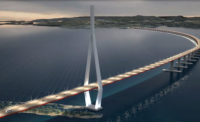Scandinavia remains “extremely good,” with major infrastructure investment plans for the next 10 to 15 years, says Søbye. The U.K. and North America are “picking up rapidly in the sectors we are in,” he says. Cowi is currently planning to expand into the U.S. highways market.
North America is “a good market across the board,” says McArthur. Howells reports “decent growth” there. Atkins has restructured its U.S. business, reducing the number of profit centers and creating a single Technical Professional Organization with some 1,800 staff in various offices. There are also five market-based units covering the business lines, such as transportation and public-private partnerships.
However, international firms are finding the U.S. a tough market to crack. “North America … is very challenging for foreign consulting companies to penetrate due to stiff competition from the big local players,” says Masahiko Mori, director at the international division of Japan’s Chodai Co. But he says infrastructure work in the U.S. shows much potential. “We would be interested to partner up with other companies in future projects,” he says.
Asia Shows Renewed Promise
For many international design firms, Asia has been slow, but it is beginning to show new promise. COWI is now looking to expand in Southeast Asia. The firm will be aided by last year’s acquisition of the U.K.-based tunneling design firm Donaldson Associates Ltd., which has a Hong Kong office.
China continues to disappoint international firms. “The most challenging country is China, where it is really difficult for international consulting engineering companies to compete in the local market,” says Goodwin. SMEC now has developed key partnerships with Chinese companies and currently is working with them to deliver significant infrastructure projects around the world, he says.
“China has significant challenges, and it is a difficult market to understand. The accelerated growth and propensity of master plans for new cities has stopped, and investment patterns are moving outside of China,” says McIntyre of IBI.
However, there is promise for the regional market with the new trade and infrastructure initiatives in the offing, including the Trans-Pacific Partnership (TPP) treaty backed by the Obama administration. “Trade agreements, such as the ambitious TPP, are helping to enhance trade and investment between countries and [creating] opportunities in the international design market,” says Greg Lowe, CEO of New Zealand’s Beca Group Ltd.
With the launch of the China-backed Asian Infrastructure Investment Bank in October 2014, “we expect more large-scale infrastructure projects funded by multilateral development banks [MDBs], including urban planning, railroads and industrial plants. More funding from MDBs would allow projects to take place in more regions,” says Park of Dohwa Engineering.
China’s recent “One Belt, One Road” initiative to fund transportation and maritime projects has had a major positive impact. The initiative covers most of Eurasia and part of Africa. This initiative targets an underdeveloped area that connects East Asia to the eurozone. Infrastructure improvement will be a prime focus, says Yan Li, vice president of China’s CCDI Group. “Creation of the Asian Infrastructure Investment Bank and the Silk Road Fund, with $100 billion and $40 billion [respectively], is already starting to impact the development of the whole region,” he says.
Singapore is still active, and there’s “a bit of resurgence” in the Philippines, while Indonesia is disappointingly quiet, says Howells. Mott recently signed a strategic partnership with China Petroleum Engineering Co. Ltd., which is trying to expand internationally, says Howells.
Working mainly on transportation, Mott’s Australian business has been little affected by falling commodity prices, says Howells. Mott also remains busy in Pakistan, though “it’s not easy to get money out,” he observes. And, after three poor years in India, the market in that country is “much slower than we thought,” he says.
Nevertheless, many designers believe India has huge potential. “I think India is full of the greatest opportunities for businesses in the international design market at the moment. There is so much pent-up demand for infrastructure of any kind. I believe being able to understand the local situations is the key to be successful there,” says Yuichiro Motomura, CEO of Japan’s PADECO Co. Ltd.
But for many international designers, India remains a challenge. “India has endured a lot of uncertainty coming up to recent elections, which has affected investment in projects across sectors, such as the automotive industry as well as the usually robust pharmaceutical and food sectors,” says Murphy of PM Group.








